While the Instructors Away, the Student Pilots Will Play! A Great Lesson in the Piper Cherokee
[This is the 14th in a series of articles detailing my journey to earning a private pilot certificate. Click to read: Part 1, Part 2, Part 3, Part 4, Part 5, Part 6, Part 7, Part 8, Part 9, Part 10, Part 11, Part 12, Part 13.]
Over the weekend, I got a text from Bryan, founder of Disciples of Flight and the owner of the High Sierra Pilots Flying Club I recently joined. He was wondering if I’d like to take a lesson in Minden, NV, flying the Piper Cherokee, with Russ, one of the club instructors. Knowing my CFI Dave is on vacation, I obviously said yes. I don’t want to go a whole week without flying!
My First Lesson with a New Instructor in the Piper Cherokee
The day came, and we headed down to Minden. I was excited to fly but somewhat nervous: new instructor, new plane- well, sort of. I’d flown 66R, the 1965 140-160 upgrade Piper Cherokee a couple times, but hadn’t done any serious maneuvering or takeoffs and landings in it at all. After my last few lessons in the wind in Truckee, I was suffering from a severe lack of self-confidence, which fed that nervousness.
We met up with Russ, an older gentleman and Civil Air Patrol pilot who recently joined High Sierra Pilots, and started going about the pre-flight. At first, I was a little annoyed. We went through it like I had never done a pre-flight before, and he didn’t want me to sump the fuel or check the brake pads (or wipe the engine oil on my jeans) because he didn’t want me to get dirty. The whole time I was making exasperated faces (as you’ll see in the pictures- Oops!) and thinking, If he thinks I can’t get down and dirty with airplanes because I’m a girl, he has another think coming.

After finishing the pre-flight outside the cockpit, we hopped inside to start ‘er up and hit the pavement. And… the battery was dead. This had happened once before to another student (it’s an older plane with an older battery, and it was cold outside), so we called the mechanic over and he gave us a jump. After that, we had no problems whatsoever!
Though I was excited to be back in a cockpit with steam gauges (the glass panel and I aren’t getting along at this point in my training), I realized that the altimeter had somehow dissolved into a meaningless orb of chaos and confusion with too many dang clock-hands pointing in ways they ought not to. By the end of the lesson, I managed to reign that in a bit and could figure out the altitude quickly enough, but for the first half, I was just taking Russ’s word for it.
Tailwind Takeoff in the Piper Cherokee
But anyway, I digress. I taxied for a minute or so, and then Russ asked for the controls so that he could confirm the brakes work (I suppose- I didn’t ask), and then immediately gave them back. He’s a very talkative and energetic person outside the cockpit, whereas I’m a bit reserved, so I was happy to find that once we were rolling he toned down the drama a bit.
We listened to the AWOS while on the roll, and it said we had a 5-knot wind coming from 150. Not being super familiar with the airport, I asked Russ, “Do you want to use runway 12 or 16 instead of 34?” which was the calm-wind runway we were taxiing toward.
“No,” he said, “It’s only 5 knots, it doesn’t matter.”
I raised my eyebrows. Noted, I thought, as I continued taxiing down Alpha to the run-up area off of runway 34. Once we were there, we went through the pre-takeoff checklist pretty quickly, I taxied us onto the centerline, and after asking Russ what Vr was (60-65 mph), we were off!
Rescuing an Indian Part 2: Finishing the Cherokee 140 Restoration Work
One thing I know about aircraft maintenance, but seem to forget, is that everything takes much longer than I anticipate. This was certainly true with 66R. The projected two months turned into five, but in the end, it really doesn’t matter how fast projects get done, just that they keep moving forward. [Read More]
Taxiing the little Cherokee is a lot of fun and relatively easy compared to the Skyhawk I’d been flying. I thought I’d hate the hand-brake, but I ended up feeling much more confident using it than I ever have using toe-brakes. It felt like it took a long time to reach Vr, and even when we did, it felt like a struggle to get 66R off the runway. I realized after the second takeoff that that was because of the tailwind, and the fact that I was used to a more dramatic pitch in the Skyhawk when you peel it off the runway, whereas the Cherokee sort of just floats off the ground when it’s ready to.
If I’m remembering correctly, we hit about 75, nearly 80 mph before getting off the ground, and about 85 for climb-out, but once we were up, the little bird was happy to be flying and responded to controls as soon as I thought about moving my hands or feet.
Freebird: Maneuvering Over Minden

All prior annoyances disappeared, and I felt myself simply beaming. I love this airplane, I LOVE this airplane! I kept thinking as we exited the pattern and headed to the practice area. Making the radio calls was almost as fun as flying: “Minden Traffic, this is Cherokee Six Six Romeo 5 miles southeast of the airport, maneuvering. Minden.”
What a sexy call sign! If you don’t believe me, say it out loud. It just rolls off the tongue.
Maneuvering: S-Turns and Crop Circles
As we were flying toward the “crop circles” near a quarry or construction site which made up the practice area, Russ asked me about S turns over a road. I’d never really done them before (just turns around a point), so he had me pick a road and go for it. I knew the basics from watching the Sporty’s videos (enter perpendicular with wings level, immediately go into a turn, and get your wings level right as you fly back over the road, etc.) so I just launched into them. The first curve of the S was much wider because I didn’t compensate for the wind, but I crossed the road wings level and managed to maintain my altitude within 40 feet or so. The second turn was much better, but I got my wings level a little too early before crossing the road.
After that, we continued our short flight to the practice area, where Russ told me we’d fly turns around a point. Cool, I thought, I’ve done those. It ended up being more like turns around a circle because Russ instructed me to follow the crop circle around while keeping it in-view off the wing, but after one go, it felt pretty good. As I mentioned a million years ago when I first flew 66R, the Cherokee just loves to turn.
Maneuvering: A Refresher in Slow Flight and Stalls
I didn’t do such a hot job holding my altitude as I did with S-turns, but after a few laps we decided to climb up to 6,700 and do some slow flight and stalls.
I had only practiced stalls once with Dave and didn’t feel super comfortable with trying them in a new airplane, but I was all hopped up on endorphins and having such a great flight I didn’t really care. All my worries sloughed off when we left ground effect.
We reached our target altitude and began the process of entering slow-flight. Carb heat on, throttle back, one notch of flaps. Russ let me just fool around in slow flight for a couple minutes before he told me to get nose high and wake up the stall warning light.
“Higher, higher, higher… okay, there it is!”
It blinked and shut off so quickly I didn’t see it, but I went about the stall recovery (as I vaguely remembered it from that one lesson) anyway. Remove flaps, nose down, carb heat off, power in, swoop to level flight. It was so quick and easy I thought I did something wrong! We didn’t even really lose altitude. As Bryan would concisely state it later after I described my flight lesson, stalling in the Cherokee is a “non-issue.”
My First Piper Cherokee Landing
After that one stall recovery, we decided to head back to the airport. Minden is truly beautiful from above. A patchwork of farmland interwoven by swaths of lavender-hued sagebrush covered desert, surrounded on all sides by the dramatic snow-covered Sierra Nevada Mountains … I could definitely see myself living down there. In that moment, I was nearly as awe-struck by the landscape as I was flying over the mountains in Truckee.
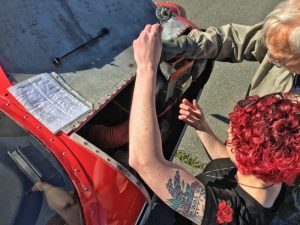
Anyway, enough waxing poetic about the high desert. We listened to the AWOS and decided that we should use runway 16, which was right traffic, but otherwise a standard rectangular pattern. What a bizarre change! We entered on the 45 and launched into the pre-landing checklist. Instead of substituting the P (Prop normally) in GUMPS for Carb Heat like I did with Dave in the Skyhawk, the P stood for fuel Pump, which made the whole acronym thing a lot better. Russ also had me add “Switches” into the S category (Seatbelts, Security, Switches) to confirm everything was in its right place.
After getting abeam the numbers (carb heat, power back to 1800 RPM, first notch of flaps when we hit the white arc) everything moved rather quickly. I made all the radio calls, and Russ told me I had a good “pilot voice,” which he explained meant that I enunciated well and sounded confident. I’ll admit this puffed up my chest a bit and I felt pretty cool. I didn’t tell him it’s just because I’m playing make-believe and imitating what I think real pilots sound like, and just grinned and went about the business of landing.
Base and final both went by quickly and smoothly, even though I felt like I was really low- again, probably just because I’m used to flying the Skyhawk and having to avoid trees and whatnot. As we got closer to the ground, I started to flare too early, but Russ quickly pointed that out and I corrected it. We got down close over the runway… closer, closer, pull back a little more, and (that torturous second or two of bracing for touch-down) we had landed. It wasn’t even that bad! In fact, though it was less smooth than I would like, it felt fairly “technically” correct: I was on (or very near) the centerline, and I landed fairly evenly on both main gears.
Instead of rapidly cleaning up and preparing for a touch-and-go, Russ instructed me to pull off and taxi back so he could fiddle with the door. In flight, the door gets opened about a half-inch (though it remains locked and secured), letting cold air in on Russ’s side, which he says makes him nervous. I say “Bah humbug, it’s fine,” but again, the wind isn’t blasting me, just him.
Let’s Go Again! (And Again)
We taxied back to the end of runway 16, and this takeoff went much quicker and smoother than the first. Apparently, people don’t just tell you to take off into a headwind because they like the sound of their own voice. We climbed up to TPA and turned back into the pattern, briefly discussing the landing and what I could do better this time before launching back into GUMPS and all that fun stuff.
This time, as we turned final, I felt a little happier with the sight picture, and we came down nice and easy. We floated for a little bit, I flared too early but corrected, and all-in-all it was seriously my best landing ever. I repeatedly asked Russ if he did anything to assist me, but he says he didn’t. It wasn’t greased on by any means, but we touched down when 66R wanted to, and squarely on both mains, and very close to the centerline.
I was freakin’ jazzed. In fact, I’m still jazzed. I’m smiling like a fool just thinking about it.
As we taxied off the runway, about to head back to the parking area, Russ asked me if I wanted to do one more. I said, “Of course!” and we changed directions and went back to runway 16. It was my best, smoothest climb out in the Cherokee yet, and I felt really good taking her around the pattern, but it definitely wasn’t my best landing. I brought us down pretty hard on the right side. “Yikes, my bad,” I said to Russ as we exited the runway and I made my final radio call of the day. We taxied back to the parking area outside Hutt Aviation, next to another Cherokee, a pretty twin-engine, and a few other sad abandoned airplanes I want to rescue, and I did my best to park us on the T without being able to see it at all (that is definitely an advantage high-wings have over low-wings).
Post-Flight Chat and Regaining My Confidence
After shutting the Cherokee down and gathering my stuff, I followed Russ out of the cockpit. God, it was gorgeous outside. The air was the perfect temperature, there was a light breeze… I mean, after such a fun flight, even the colors seemed brighter. I just couldn’t stop smiling.
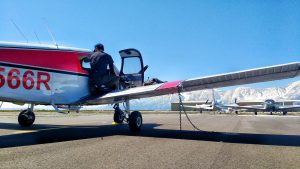
Bryan had walked over and just got off a phone meeting when Russ decided to go get his stuff out of the cockpit. I meandered around looking at the airplanes before sitting down on the asphalt and enjoying the sun on my skin, smiling at nothing.
Bryan went over to the airplane to chat with Russ about its performance, and they talked for a while. So long, in fact, I got pretty sunburned.
After they were done, they both came over and joined me on the ground. We all chatted about the flight lesson and the airplane and everything else, and I handed Russ my logbook to fill out. I felt a little nervous about Dave seeing that I had a lesson with another instructor after our discussion about waiting ‘til I soloed, but… oh well.
Russ cut me a deal on our flight lesson, and we went our separate ways. While walking over to Sierra Skyport (Bryan had a meeting with the guy there about renting a building for the flight club and school), he told me that Russ said that I did really well, and that he thought I could solo after just one more lesson, that I was “ready.” He said that he thought I was wasting my money up at Truckee, and that he wasn’t prepared for me to be so far along in my training and pilot skills. I felt so excited and proud!
As cheesy as it is, I literally fell asleep smiling that night. For the first time in a while, I feel like I’m really on my way to becoming a pilot.
Featured Image and all other photos taken by Bryan Stewart of Disciples of Flight, unless otherwise marked.
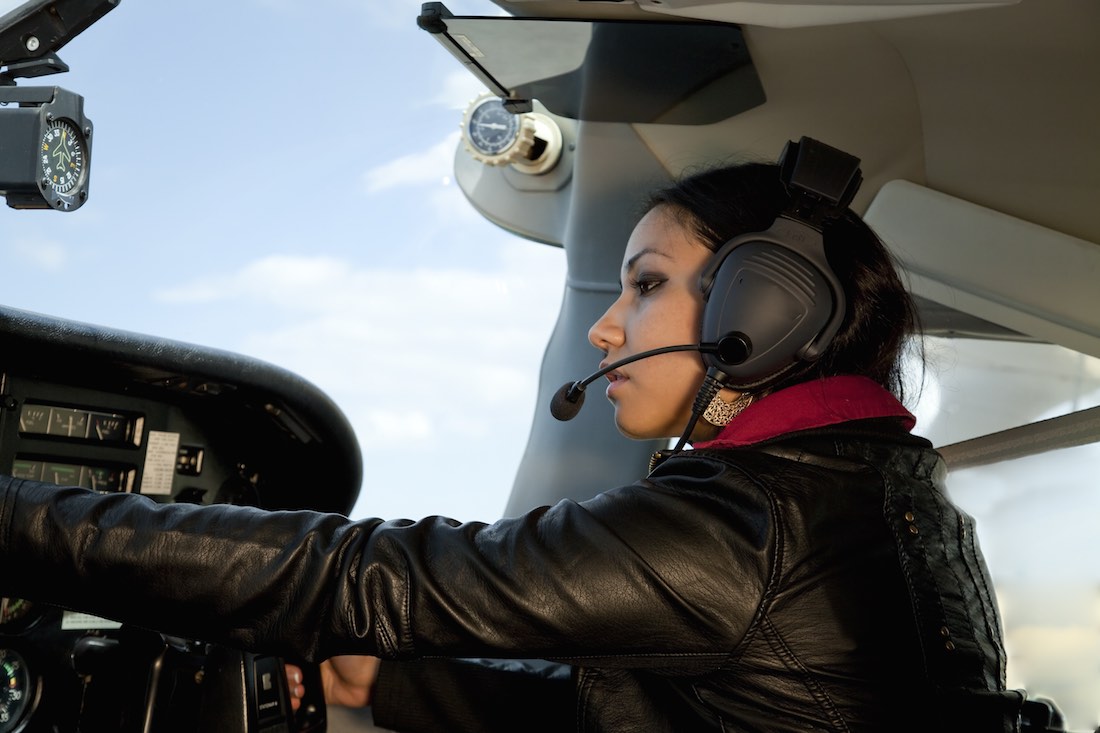
Find the Right CFI for You
Most student pilots drop out before they get their pilot’s license, often because of problems with their CFI. Certificated pilots may face ongoing CFI problems, or they may become too comfortable one instructor and shy away from new challenges that could lead to improved flight skills. When I decided to earn my private license, we already owned a Cessna 210 [Read More]






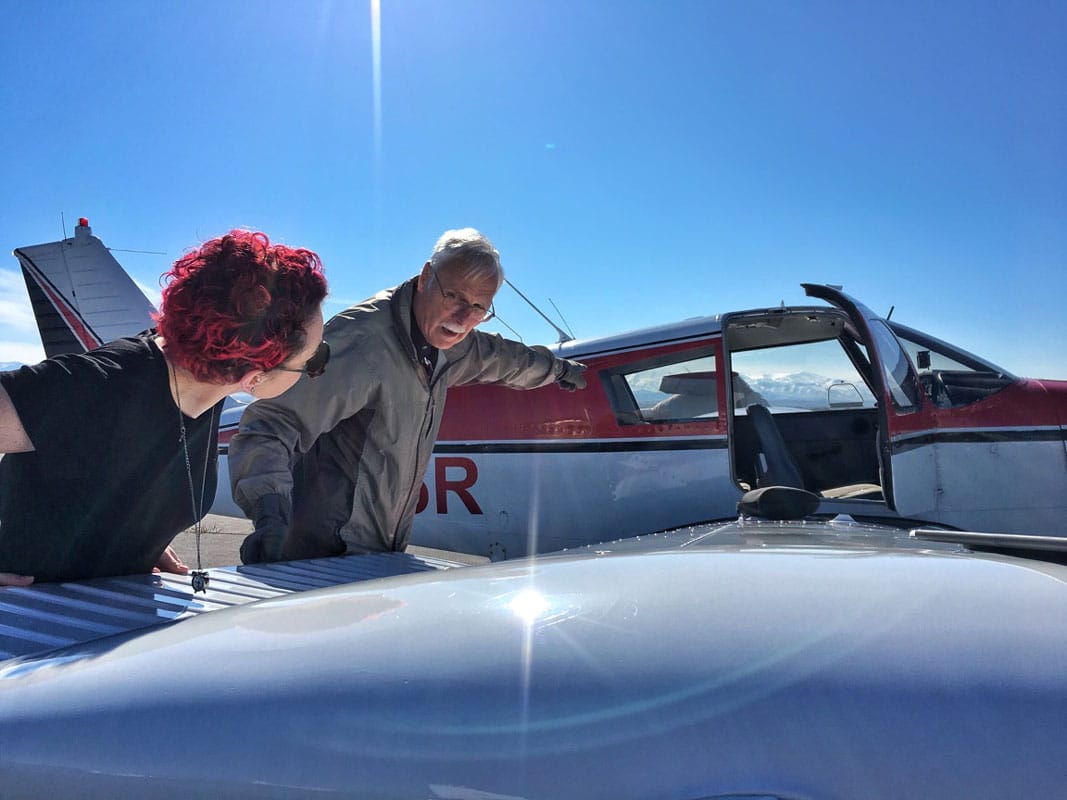

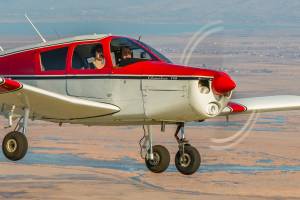







I enjoyed reading the article about the young lady taking her pilot’s training flight up in Minden. Brought back a lot of great memories for me in the Piper Cherokee 140. I felt as though I was right there in the cabin with her and the instructor. This seems like a pretty good publication (my first time reading it). I’m looking forward to catching more reading. Thank you.
Thank you so much Bobby. I love sharing my flying experiences with everyone! Thanks for reading, and I hope you enjoy future articles just as much.